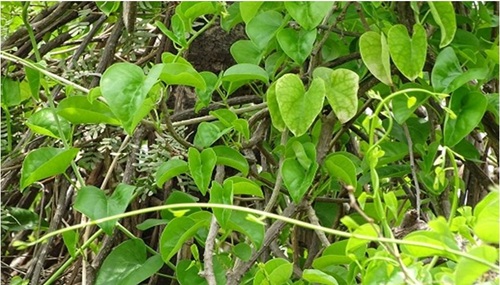In Ayurveda, Giloy is considered one of the most powerful herbs for boosting immunity, fighting infections, and improving overall health. Also known as Amrita or Guduchi, this climbing shrub is widely used in Indian households, especially after the COVID-19 pandemic, for its medicinal benefits. However, many people confuse it with similar-looking plants like betel or heart-leaf moonseed. To ensure safety and effectiveness, it’s important to know how to correctly identify the Giloy plant.

1. Stem Characteristics
- The stem of Giloy is its most distinctive feature.
- Appearance: It is green, smooth, and cylindrical with a fleshy texture.
- Unique Marks: The stem often shows raised circular nodes or marks, which look like small round bumps. These are considered “leaf scars” where leaves once grew.
- Color: Fresh stems are light green, and mature stems may appear woody and brownish.
- Taste: If you chew a tiny bit, the stem is bitter, a signature trait of Giloy.
2. Leaves of Giloy
- Giloy leaves are heart-shaped (cordate), resembling betel leaves, but they are thinner and less glossy.
- Size: Around 4–15 cm long and 3–10 cm wide.
- Color: Fresh green with prominent veins.
- Difference from Betel Leaf: Betel leaves are thicker, shiny, and pungent in smell, while Giloy leaves are plain and odorless.
3. Growth Pattern
- Giloy is a climbing creeper (climber) that grows by wrapping itself around trees, walls, or supports.
- It often grows on Neem or Mango trees, and when it does, it is believed to carry even more medicinal value.
- It spreads rapidly in tropical and subtropical climates, commonly seen in gardens, backyards, and forest edges.
4. Flowers and Fruits
Though not always noticed, Giloy produces small flowers and fruits:
- Flowers: Small, yellow or greenish, usually appear in clusters during summer.
- Fruits: Round, pea-sized, red or orange berries when ripened.
- These features confirm the plant’s identity if observed during its flowering season.
5. Bark and Inner Stem
- If you peel the outer stem, the inner part is fibrous and moist.
- The inside has a watery gel-like substance that tastes bitter.
- This bitter juice is often extracted for medicinal use.
6. Common Confusions with Other Plants
Many people confuse Giloy with other creepers:
- Betel Leaf (Paan): Thick, shiny leaves with pungent smell. Giloy leaves are thinner and odorless.
- Heartleaf Moonseed (Tinospora crispa): Similar structure but grows mainly in Southeast Asia.
- To avoid confusion, always check the circular scars on the stem—a unique identity of Giloy.
7. Where to Find Giloy
- Naturally grows in tropical regions of India.
- Easily available in Ayurvedic nurseries, gardens, and homes.
- Nowadays, Giloy cuttings are also sold in plant nurseries and online stores.
8. Quick Checklist to Identify Giloy
| Feature | Giloy Plant Characteristics |
| Stem | Green, smooth, with circular scars, bitter taste |
| Leaves | Heart-shaped, thin, plain green, odorless |
| Growth | Climber, wraps around trees like Neem or Mango |
| Flowers | Small, yellow-green clusters |
| Fruits | Small, round, red/orange berries |
Final Thoughts
The Giloy plant can be easily identified if you carefully observe its heart-shaped leaves, circular scars on the stem, climbing nature, and bitter taste. While it resembles some other creepers, its unique stem marks and medicinal bitterness set it apart. Recognizing the real Giloy is essential to ensure you are consuming the correct herb for immunity and wellness, as using a wrong plant may not only be ineffective but also harmful.